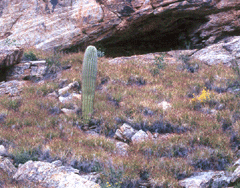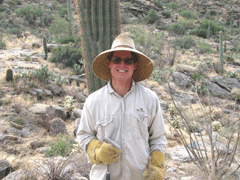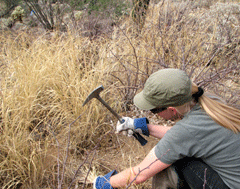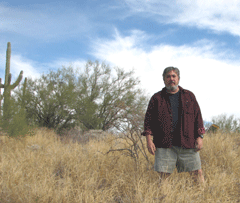Invasion of the Invasives
Air Date: Week of August 15, 2008

Buffelgrass plants surrounding a young saguaro cactus, Saguaro National Park, Arizona.
Buffelgrass, a non-native grass, is spreading like wildfire through Saguaro National Park in Tucson, Arizona, threatening the parkÂ’s signature cacti and posing a fire threat to homes near the mountains. Jim Williams of station KUNM reports that scientists and volunteers are whacking away, trying to keep ahead of the relentless plant. (7:30)
Transcript
GELLERMAN: It's Living on Earth, I'm Bruce Gellerman, with this encore edition. The Sonoran Desert extends from northwest Mexico into most of southern Arizona and part of California. It's a landscape stark and beautiful, a huge hot desert, full of unique animals, colorful birds and bizarre plants. Among them - the giant Saguaro Cactus. You know, the one that looks like a giant scarecrow, with spiny outstretched arms. But now the saguaro has to fend off a new threat: non-native grasses. They're spreading like wildfire – and that's the problem. The rapidly growing grasses burn fiercely – as Jim Williams of KUNM Radio found when he visited Saguaro National Park near Tucson, Arizona.
NATS: [Hacking at buffelgrass, pulling, grunting.]
JOHNSON: You give it a, sometimes a good twist here, kinda like a rope it holds it together better. They get down in the crevices, which makes it a little more creative to get 'em out.
WILLIAMS: On an afternoon that would be called hot by most anyone not from Arizona, Matt Johnson hacks away with a steel pick on a rocky slope in Saguaro National Park. He's one of eight volunteers from the Arizona Native Plant Society who are pulling a stubborn non-native plant called buffelgrass.
GRAFFAM: Incredible.
WILLIAMS: Clint Graffam says he can't believe how fast this Sonoran desert's filling up with these wheat-colored clumps.

Buffelgrass plants surrounding a young saguaro cactus, Saguaro National Park, Arizona. (Photo by Todd Esque, USGS)
WILLIAMS: Buffelgrass is from Ethiopia, where it was named after the buffalo who loved it. The U.S. government imported it in 1938 and planted it in trial plots for use as cattle food and to reduce soil erosion in the American Southwest. Back then, it had a difficult time getting established. But fast-forward about seventy years, and it's now found its way to roadsides in Tucson, and within the past few years itÂ’s spread like, well, wildfire, up into the desert and onto its surrounding hillsides. Some scientists believe global warming could be fueling the spread: Tucson's in a multi-year drought, and average summer temperatures have been increasing. Whatever the reason, though, buffelgrass loves it here now. And while the sight of it is troubling, botanists and ecologists are most worried about the fire it will inevitably bring. The grass, which is tinder-dry and dormant for most of the year, burns quickly and at very high temperatures. Matt Johnson has just cleared a skirt of bufflegrass from around the base of a massive saguaro.
JOHNSON: This saguaro will not now burn if a fire were to come start tomorrow in this remaining patch of grass, and kinda like people, saguaros, if they get more than about sixty percent of their stem surface burned, same as severe burn victims, the survival rate goes way down. Just a little singeing around the base they'll handle, but, Whew! [Laughs.]

Volunteer Matt Johnson holds a clump of buffelgrass. (Photo: Jim Williams)
HANSEN: There are a lot of homeowners in the foothills and such that have major infestations of this grass. I don't know how aware they are, but this poses a real threat to their property as well. This grass burns very vigorously with very tall flame. And it's easily able to destroy a house, and all the plants, including saguaros, around it.
BETANCOURT: It is the plant from hell.
WILLIAMS: Julio Betancourt is a senior scientist with the U-S Geological Survey. In recent years, he's been all over the media around the world talking about buffelgrass. Betancourt stands and points up at the southern base of the Catalina Mountains, which rise out of what's quickly becoming north Tucson.
BETANCOURT: And you can see all these patches, like do you see that patch right down there, that's buffelgrass right there. Do you see that patch over there next to Pima Canyon? Buffelgrass. When you start looking down the mountain you start picking out all these little patches. And that's all buffelgrass, and eventually, the whole ridge will be buffelgrass.

Pima Community College student Shelly Lyons digs up buffelgrass as part of her biology class service learning project. (Photo: Jim Williams)
BETANCOURT: I think humans have this animalistic visceral reaction to changes on the landscape. And I think the same thing is already happening with the population in Tucson, that they notice something is changing, and changing very, very fast.
WILLIAMS: Well, the Park Service has noticed, that's for sure. It's partnered with the Arizona Native Plant Society and a relentless group named the Sonoran Desert Weed Wackers to build an impressive team of buffelgrass-tackling volunteers. But it's a foot race the grass seems to be winning. Meg Weesner is Saguaro National ParkÂ’s chief of Science and Resources Management. She says researchers are seeing native plants like the green-trunked paloverde and saguaro dying out in stands of buffelgrass, their water supply cut off by the invaders. Southern California has seen invasive grasses take over in similar ways in recent years. Weesner says think of the fires there as exactly what could happen in Tucson and Saguaro National Park.

USGS Senior Scientist Julio Betancourt in a field of buffelgrass. (Photo: Jim Williams)
WILLIAMS: That process kills the native Sonoran plants, turning the desert into an African savanna, a grassland. In places in northern Mexico, thatÂ’s already happened. And itÂ’s an expensive problem. Buffelgrass has now spread into a thousand acres of Saguaro National Park. Without the help of volunteers, removing the buffelgrass can cost over $13,000 dollars an acre. Weesner says the park service has also begun herbicide spraying on the grass because digging it up can actually spread the seeds. But spraying costs $1200 dollars an acre. And because the chemical has to be absorbed by the plant, the buffelgrass can only be sprayed when itÂ’s green, which means a very short window of opportunity in the summer. Add to that the fact that the chemical is essentially a version of Roundup, which some studies have shown might harm soil bacteria and amphibians. But the volunteers out on the hillside in the park say fire is a much more immediate and devastating threat. Meg Weesner says all the challenges require a huge collective effort.
WEESNER: The park has partnered with almost everybody who manages a plot of large ground in the Tucson basin. We have all of the land managing agencies, all the departments of transportation, and we actually had a summit last winter to develop a coordinated effort, because it doesnÂ’t help to get rid of the grass on one side of the fence if itÂ’s on the other.
WILLIAMS: And with a lack of federal funding to deal proactively with invasives, Weesner says the Park Service is struggling to stay on top of it all. But she adds that, with the battalion of volunteers, the city of Tucson and Pima County all in on the buffelgrass fight, sheÂ’s hopeful.
WEESNER: You have to be an optimist in this field. [Laughs.] ItÂ’s the only way to be.
NATS: [hacking, pulling, and grunting sounds]
WILLIAMS: Back in the buffelgrass-choked Saguaro National Park, volunteer Matt Johnson keeps swinging his pick.
JOHNSON: ItÂ’s job security, I guess. [Laughs.] [hacking, pulling and grunting sounds]
WILLIAMS: For Living on Earth, IÂ’m Jim Williams, in Saguaro National Park.
Links
Living on Earth wants to hear from you!
Living on Earth
62 Calef Highway, Suite 212
Lee, NH 03861
Telephone: 617-287-4121
E-mail: comments@loe.org
Newsletter [Click here]
Donate to Living on Earth!
Living on Earth is an independent media program and relies entirely on contributions from listeners and institutions supporting public service. Please donate now to preserve an independent environmental voice.
NewsletterLiving on Earth offers a weekly delivery of the show's rundown to your mailbox. Sign up for our newsletter today!
 Sailors For The Sea: Be the change you want to sea.
Sailors For The Sea: Be the change you want to sea.
 The Grantham Foundation for the Protection of the Environment: Committed to protecting and improving the health of the global environment.
The Grantham Foundation for the Protection of the Environment: Committed to protecting and improving the health of the global environment.
 Contribute to Living on Earth and receive, as our gift to you, an archival print of one of Mark Seth Lender's extraordinary wildlife photographs. Follow the link to see Mark's current collection of photographs.
Contribute to Living on Earth and receive, as our gift to you, an archival print of one of Mark Seth Lender's extraordinary wildlife photographs. Follow the link to see Mark's current collection of photographs.
 Buy a signed copy of Mark Seth Lender's book Smeagull the Seagull & support Living on Earth
Buy a signed copy of Mark Seth Lender's book Smeagull the Seagull & support Living on Earth

